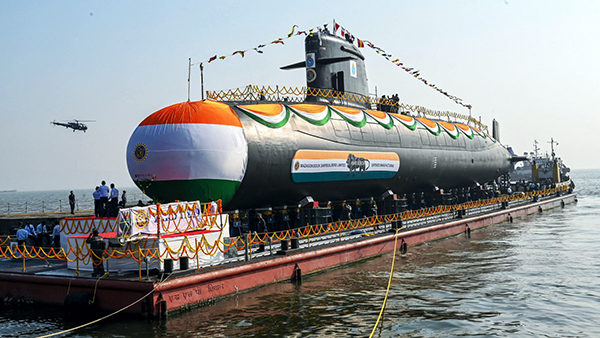Indian Navy’s fifth Scorpene-class submarine Vagir, having superior stealth features like the advanced acoustic absorption technique, was launched on 12 November at the Mazagon Dock Ltd (MDL), Mumbai.
Vagir is part of the six Kalvari-class submarines being built in India. The submarines, designed by French naval defence and energy company DCNS, are being built as part of Indian Navy’s Project-75.
These submarines can undertake missions like anti-surface warfare, anti-submarine warfare, intelligence gathering, mine laying, and area surveillance.
Vagir is named after the Sand Fish, a deadly deep sea predator of the Indian Ocean. The first Vagir, a submarine from Russia, was commissioned into the Indian Navy on December 3, 1973, and was decommissioned on June 7, 2001 after almost three decades of service to the nation.
ALSO READ: Review of Indian Navy’s Modernisation
“Building the Scorpene was indeed a challenge for MDL, as the complexity of the simplest of tasks increased exponentially due to all work having to be done in the most congested of spaces,” MDL said in a release.
“The state-of-art technology used in the submarine has ensured superior stealth features such as advanced acoustic absorption techniques, low radiated noise levels, and hydro- dynamically optimised shape and also the ability to attack the enemy using precision guided weapons,” the release said.
The attack can be launched with both torpedoes and tube launched anti-ship missiles, whilst underwater or on surface, MDL said. “The stealth of this potent platform is enhanced by the special attention to her characteristic underwater signatures. These stealth features give it an invulnerability, unmatched by most submarines,” it said.
The submarine is designed to operate in all theatres of operation, showcasing interoperability with other components of a Naval Task Force, MDL said.
“With the launching of Vagir, India further cements its position as a submarine building nation. This is in sync with the current impetus of the government towards Make in India and AtmaNirbhar Bharat,” MDL said.
Two submarines of the ongoing Project-75 Scorpeneprogramme at MDL, Kalvari and Khanderi, have been commissioned into the Indian Navy. The third submarine, Karanj, is in the last phase of rigorous sea trials. The fourth Scorpene, Vela, has commenced her sea trials, whilst the sixth and last submarine, Vagsheer, is being readied for boot together.
“Two SSK submarines built by MDL during 1992-94 are in active service, which is a testimony to the professionalism and capability of Mazagon Dock personnel,” it said.
INS Kavaratti ASW Corvette Commissioned
Army chief Gen MM Naravane, on 22 October, commissioned anti-submarine warfare (ASW) ship INS Kavaratti into the Indian Navy at the Naval Dockyard in Visakhapatnam. Kavaratti is the last of four indigenously-built ASW under ‘Project 28’ or orKamorta-class corvettes of the Navy. It is a class of ASWs currently in service with the Navy.
‘Project 28’ was approved in 2003. The other three warships under this project are INS Kamorta (commissioned in 2014), INS Kadmatt (2016) and INS Kiltan (2017).
The 109 metres long INS Kavaratti (pennant number P 31) incorporates stealth features in its design as well as 90% indigenous content, including the use of carbon composites. The use of carbon composites to build it has been described as a ‘commendable feat achieved in Indian shipbuilding.
The warship has been designed by the Navy’s in-house organisation, the Directorate of Naval Design (DND). Kolkata’s Garden Research Shipbuilders and Engineers (GRSE), meanwhile, has built it. It has state-of-the-art weapons and a sensor that can detect and take action against hostile submarines. It also has a good endurance for long-range deployments.
ALSO READ: NAVY MODERNISATION: Six P-75I Conventional Submarines to be Built
Kavaratti has completed sea-trials of all its systems fitted onboard and, hence, will be commissioned as a combat-ready platform.
The IN said in a statement that the corvette, which has an overall beam of 12.8 m and is capable of achieving speeds up to 25 kt, was commissioned as a ‘combat-ready’ platform following the completion of sea trials.
Among other things, the Kamorta class is equipped with two licence-built RBU-6000 anti-submarine rocket launchers, one Oto Melara 76 mm/62 Super Rapid gun, and four Larsen & Toubro indigenous twin torpedo launchers for the locally designed Varunastra torpedoes, which have a stated range of up to 40 km.
INS Kavaratti derives its name from the eponymous INS Kavaratti, which was an Arnala class missile corvette. The older INS Kavaratti operated during the 1971 Bangladesh liberation war.
Smart Shooter ‘SMASH 2000’ Rifle Sights for Navy
India’s Navy Chief, Admiral Karambir Singh, said at his annual press conference, on 3 December, that the Navy was procuring SMASH 2000 rifle sights, manufactured by Israeli company Smart Shooter, as protection against drone attacks. This acquisition, according to the Admiral, was one of the steps taken by the Indian Navy against possible naval threats on the part of China. No details were provided regarding the quantity, cost or timing of delivery. The Admiral also confirmed that Heron UAVs, which are manufactured by Israel’s IAI, were deployed on India’s northern border with China amid continuing tensions between the countries in the region of Eastern Ladakh.
The SMASH 2000 is a smart electro-optical rifle sight that includes a fire control computer. The sight significantly increases operational shooting accuracy and significantly improves the hit rate for a variety of targets, both stationary and mobile.
Smart Shooter was awarded a contract by India’s defense ministry for the supply of SMASH 2000 Plus systems that will be installed mainly on AK-47/103 rifles. According to the company, the improved accuracy and speed of hitting targets will dramatically increase each soldier’s confidence in any combat scenario and maximize operational effectiveness.


















